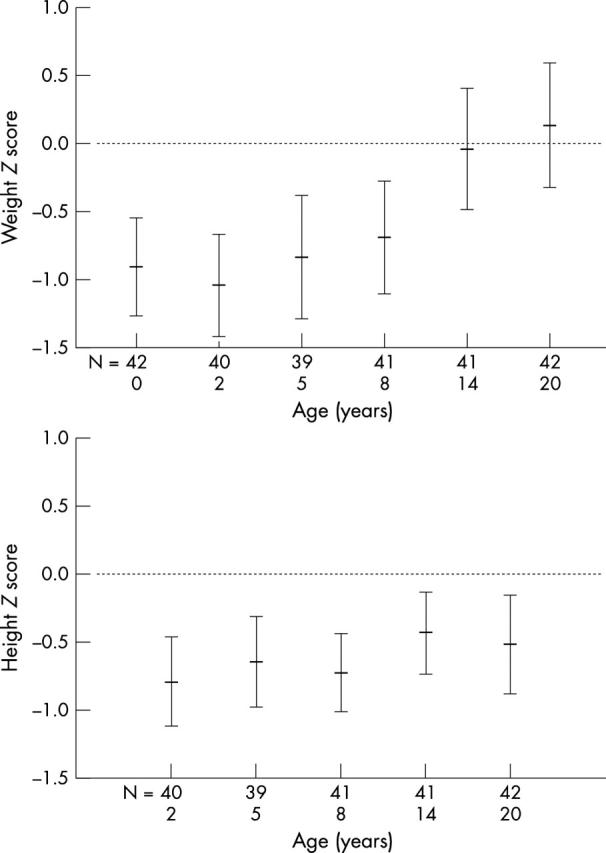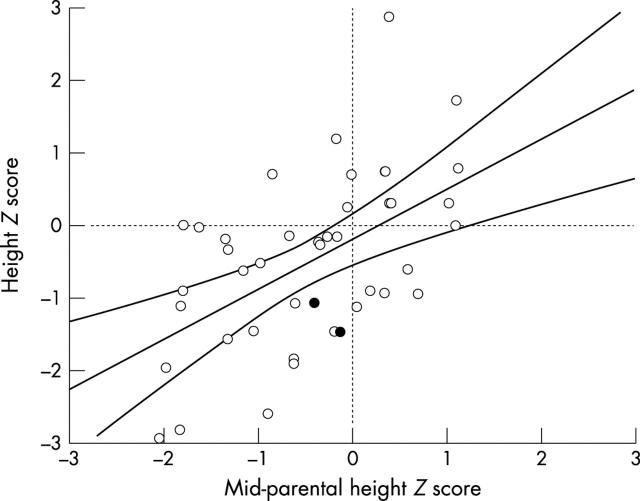Abstract
Aims: To determine the body size of extremely low birth weight (ELBW, birth weight 500–999 g) subjects in early adulthood.
Methods: Cohort study examining the height and weight of 42 ELBW survivors free of cerebral palsy between birth and 20 years of age. Weight and height measurements were converted to Z (SD) scores.
Results: At birth the subjects had weight Z scores substantially below zero (mean birth weight Z score -0.90, 95% CI -1.25 to -0.54), and had been lighter than average at ages 2, 5, and 8 years. However, by 14, and again at 20 years of age their weight Z scores were not significantly different from zero. At ages 2, 5, 8, 14, and 20 years of age their height Z scores were significantly below zero. Their height at 20 years of age was, however, consistent with their parents' height. As a group they were relatively heavy for their height and their mean body mass index (BMI) Z score was almost significantly different from zero (mean difference 0.42, 95% CI -0.02 to 0.84). Their mean BMI (kg/m2) was 24.0 (SD 5.2); 14 had a BMI >25, and four had a BMI >30.
Conclusions: Despite their early small size, by early adulthood the ELBW subjects had attained an average weight, and their height was consistent with their parents' height. They were, however, relatively heavy for their height.
Full Text
The Full Text of this article is available as a PDF (166.8 KB).
Figure 1 .

Subjects' weight and height Z scores (mean and 95% CI) through to age 20. Sample size shown at the bottom.
Figure 2 .
Relation between subjects' height Z scores at age 20 and their mid-parental height Z scores (mean and 95% CI for regression shown). The two subjects treated with growth hormone are shown as filled circles.
Selected References
These references are in PubMed. This may not be the complete list of references from this article.
- Brothwood M., Wolke D., Gamsu H., Cooper D. Mortality, morbidity, growth and development of babies weighing 501-1,000 grams and 1,001-1,500 grams at birth. Acta Paediatr Scand. 1988 Jan;77(1):10–18. doi: 10.1111/j.1651-2227.1988.tb10590.x. [DOI] [PubMed] [Google Scholar]
- Cole T. J., Freeman J. V., Preece M. A. British 1990 growth reference centiles for weight, height, body mass index and head circumference fitted by maximum penalized likelihood. Stat Med. 1998 Feb 28;17(4):407–429. [PubMed] [Google Scholar]
- Doyle L. W., Ford G. W., Abadilla B., Warne G. L., Callanan C. Assessment of short stature in very low birthweight children. J Paediatr Child Health. 1993 Dec;29(6):411–414. doi: 10.1111/j.1440-1754.1993.tb03010.x. [DOI] [PubMed] [Google Scholar]
- Doyle L. W. Growth and respiratory health in adolescence of the extremely low-birth weight survivor. Clin Perinatol. 2000 Jun;27(2):421–432. doi: 10.1016/s0095-5108(05)70029-4. [DOI] [PubMed] [Google Scholar]
- Ford G. W., Doyle L. W., Davis N. M., Callanan C. Very low birth weight and growth into adolescence. Arch Pediatr Adolesc Med. 2000 Aug;154(8):778–784. doi: 10.1001/archpedi.154.8.778. [DOI] [PubMed] [Google Scholar]
- Hirata T., Bosque E. When they grow up: the growth of extremely low birth weight (< or = 1000 gm) infants at adolescence. J Pediatr. 1998 Jun;132(6):1033–1035. doi: 10.1016/s0022-3476(98)70404-4. [DOI] [PubMed] [Google Scholar]
- Järvenpä A. L., Vlrtanen M., Pohjavuori M. The outcome of extremely low birthweight infants. Ann Med. 1991 Dec;23(6):699–704. doi: 10.3109/07853899109148106. [DOI] [PubMed] [Google Scholar]
- O'Callaghan M. J., Burns Y., Gray P., Harvey J. M., Mohay H. I., Rogers Y., Tudehope D. I. Extremely low birth weight and control infants at 2 years corrected age: a comparison of intellectual abilities, motor performance, growth and health. Early Hum Dev. 1995 Jan 30;40(2):115–128. doi: 10.1016/0378-3782(94)01597-I. [DOI] [PubMed] [Google Scholar]
- Peralta-Carcelen M., Jackson D. S., Goran M. I., Royal S. A., Mayo M. S., Nelson K. G. Growth of adolescents who were born at extremely low birth weight without major disability. J Pediatr. 2000 May;136(5):633–640. doi: 10.1067/mpd.2000.104291. [DOI] [PubMed] [Google Scholar]
- Saigal S., Stoskopf B. L., Streiner D. L., Burrows E. Physical growth and current health status of infants who were of extremely low birth weight and controls at adolescence. Pediatrics. 2001 Aug;108(2):407–415. doi: 10.1542/peds.108.2.407. [DOI] [PubMed] [Google Scholar]



